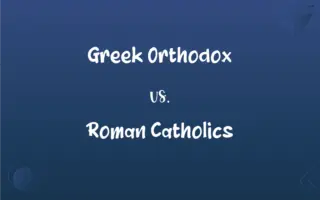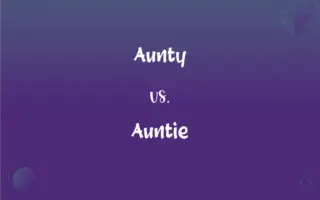Braids vs. Plaits: What's the Difference?
Edited by Aimie Carlson || By Janet White || Published on April 27, 2024
Braids and plaits both refer to a style of intertwining three or more strands of hair or other flexible material, with "braids" being the more commonly used term in American English and "plaits" more prevalent in British English.

Key Differences
Both braids and plaits are methods of hair styling involving intertwining strands of hair. Braids are often seen as a broader term, encompassing a variety of styles including complex patterns. Plaits, on the other hand, typically refer to the basic three-strand weave and are more traditional in nature.
Braids carry significant cultural heritage in many societies, often used in elaborate hairstyles for special occasions. Plaits, while also culturally significant, are more commonly associated with simpler, everyday styles in various cultures.
Braids can include diverse variations like French braids, Dutch braids, and cornrows, demonstrating a wide range of complexity. Plaits, in comparison, are generally straightforward and do not vary as much in technique.
The term braids is predominantly used in American English, representing a wide array of styles. Plaits is a term more commonly used in British English and often suggests a more basic, three-strand style.
The concept of braids extends beyond hair, used in various crafts and designs. Plaits, while also used in a broader context, are typically associated with the basic technique of intertwining material, be it hair or otherwise.
ADVERTISEMENT
Comparison Chart
Terminology Usage
More common in American English.
More common in British English.
Complexity
Can be more complex (e.g., fishtail).
Generally simpler, classic 3-strands.
Cultural Association
Varied cultural significance.
Often seen as more traditional.
Variations
Numerous variations (e.g., cornrows).
Limited variations.
Application Beyond Hair
Used in crafts, fabrics, etc.
Also used in crafts but less varied.
ADVERTISEMENT
Braids and Plaits Definitions
Braids
A technique of weaving hair or fibers.
He learned to create colorful braids with yarn.
Plaits
A basic form of three-strand weaving, often in hair.
Her long hair was neatly arranged in plaits.
Braids
A complex pattern formed by overlapping three or more strands.
Her favorite hairstyle is a French braid.
Plaits
A simple technique of intertwining strands.
She decorated the gift with a ribbon plait.
Braids
Interwoven strands of hair or material.
She wore her hair in elegant braids for the wedding.
Plaits
A three-stranded braid, especially in British English.
Plaits are her go-to hairstyle for busy mornings.
Braids
A plaited structure formed by intertwining materials.
The basket was made with intricately braided reeds.
Plaits
A traditional style of braiding hair.
The children wore their hair in plaits for the school play.
Braids
A form of hairstyle or decoration using interwoven strands.
Braids adorned her dress, adding a unique touch.
Plaits
A method of forming a pattern by crossing strands.
He crafted a bracelet using leather plaits.
Braids
To interweave three or more strands, strips, or lengths of in a diagonally overlapping pattern
Braided the rags into a strong rope.
Plaits
A braid, especially of hair.
Plaits
A pleat.
Plaits
To braid.
Plaits
To pleat.
Plaits
To make by braiding.
Plaits
Plural of plait
Plaits
Infl of plait
FAQs
What are plaits?
Plaits refer to the basic three-strand weave, often used in hair styling.
What are braids?
Braids are a style of intertwining three or more strands of hair or material.
Is there a difference between braids and plaits?
The terms are often used interchangeably, but braids can be more complex.
Do plaits have cultural significance?
Yes, plaits are traditional in many cultures, often symbolizing simplicity.
Are plaits only for hair?
No, plaits can also be used in crafting and decoration.
Are plaits always simple?
Plaits typically refer to a basic three-strand braid, but can vary slightly.
Are braids cultural?
Yes, braids have significant cultural meanings in various societies.
What's the origin of braids?
Braids have ancient origins in various cultures worldwide.
How do braids vary?
Braids have many variations like French, Dutch, and cornrows.
Can anyone wear plaits?
Yes, plaits are versatile and can be worn by anyone.
What's a popular braid style?
The French braid is a popular and versatile style.
What's a common plait style?
The classic three-strand plait is the most common.
Can braids be formal or casual?
Yes, braids can be styled for both formal and casual occasions.
Do braids work on all hair types?
Braids can be adapted to most hair types, with varying styles.
Can braids be used in crafts?
Yes, braids are used in various crafts and designs.
Where do plaits come from?
Plaits also have a long history, prevalent in many early cultures.
Are plaits suitable for formal events?
Plaits can be dressed up for formal events, depending on the style.
Are braids and plaits only for long hair?
No, they can be adapted for different hair lengths, though easier with longer hair.
Do braids require special skills?
Complex braids might require more skill and practice.
Are plaits easy to do?
Yes, basic plaits are relatively easy to learn.
About Author
Written by
Janet WhiteJanet White has been an esteemed writer and blogger for Difference Wiki. Holding a Master's degree in Science and Medical Journalism from the prestigious Boston University, she has consistently demonstrated her expertise and passion for her field. When she's not immersed in her work, Janet relishes her time exercising, delving into a good book, and cherishing moments with friends and family.
Edited by
Aimie CarlsonAimie Carlson, holding a master's degree in English literature, is a fervent English language enthusiast. She lends her writing talents to Difference Wiki, a prominent website that specializes in comparisons, offering readers insightful analyses that both captivate and inform.







































































